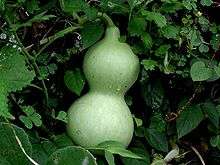Lagenaria
| Lagenaria | |
|---|---|
 | |
| The calabash (L. siceraria) | |
| Scientific classification | |
| Kingdom: | Plantae |
| (unranked): | Angiosperms |
| (unranked): | Eudicots |
| (unranked): | Rosids |
| Order: | Cucurbitales |
| Family: | Cucurbitaceae |
| Subfamily: | Cucurbitoideae |
| Tribe: | Benincaseae |
| Subtribe: | Benincasinae |
| Genus: | Lagenaria Ser. |
| Species | |
| |
| Synonyms | |
Lagenaria is a genus of gourd-bearing vines in the squash family (Cucurbitaceae). Lagenaria contains six species, all of which are indigenous to tropical Africa.[1] The best-known species, the bottle gourd, L. siceraria, has been domesticated by humans, and has spread beyond Africa. The other species are not cultivated.[1] The gourds of the various species may be harvested young and used as a vegetable. More commonly, the gourds are harvested mature, then dried, and used in making utensils (including musical instruments and containers). Gourds of L. siceraria have been used to store water and other liquids since ancient times. The generic name lagenaria comes from classical Latin lagena meaning bottle or flask, plus Latin suffix -aria.[2]
References
- 1 2 "Pollinators and biological diversity: the case of the bottle gourd (Lagenaria siceraria) in Kenya", by Morimoto Y., Gikungu M., and Maundu P., year 2004. "Notes on Lagenaria and Cucurbita (Cucurbitaceae)", by Herwig Teppner, year 2004 on page 252.
- ↑ Lagenaria in The Names of Plants, by David Gledhill, year 2008 (see also lagena in Latin-English Dictionary, by William Whitaker).
| External identifiers for Lagenaria | |
|---|---|
| ITIS | 22385 |
| NCBI | 3667 |
| Also found in: Wikispecies | |
This article is issued from Wikipedia - version of the 11/6/2016. The text is available under the Creative Commons Attribution/Share Alike but additional terms may apply for the media files.